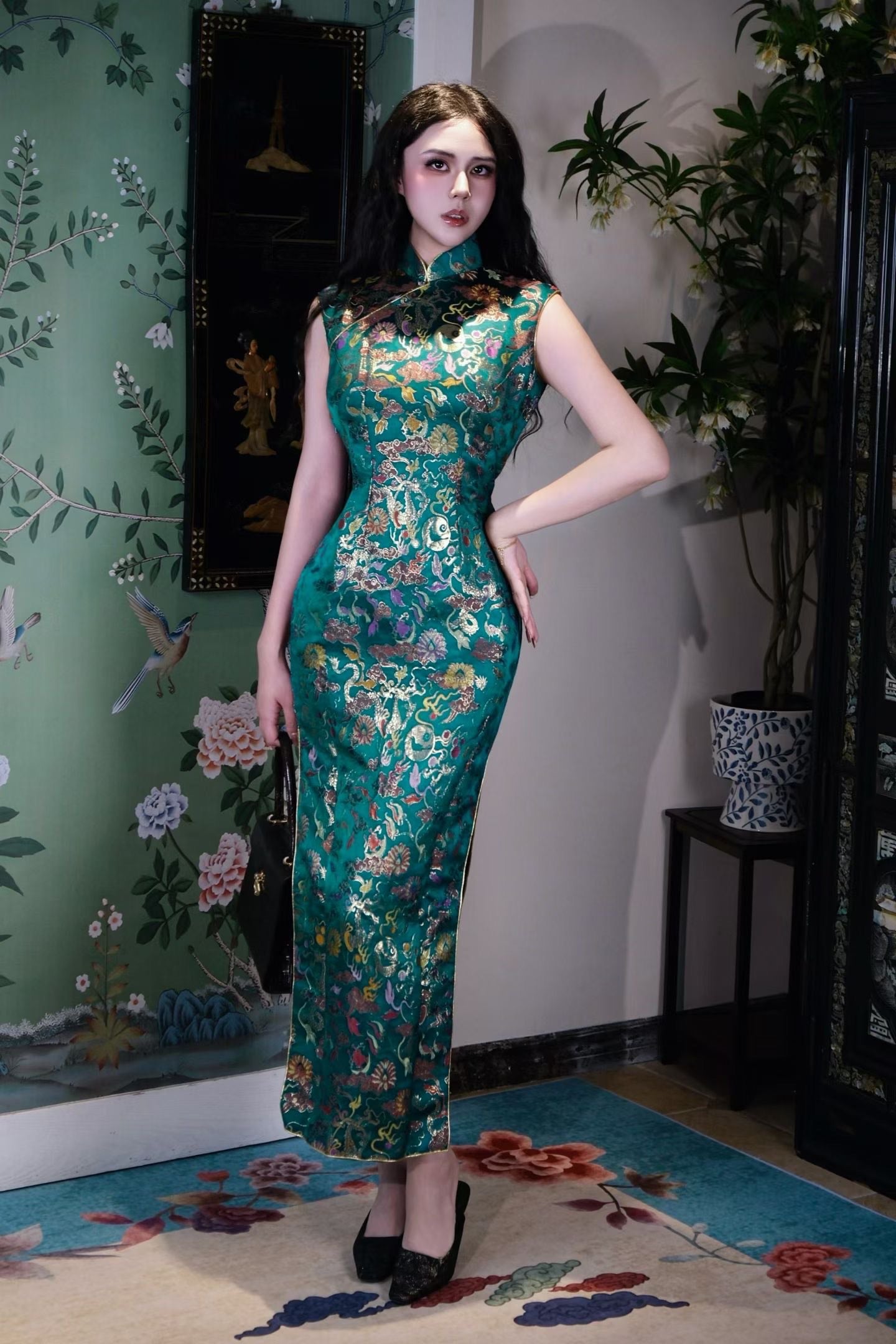深圳溯源
60年代 - 香港云龙旧梦织金提花缎旗袍 | 1960s - Hong Kong "Cloud Dragon Old Dream" Gold-Woven Brocade Qipao
60年代 - 香港云龙旧梦织金提花缎旗袍 | 1960s - Hong Kong "Cloud Dragon Old Dream" Gold-Woven Brocade Qipao
无法加载取货服务可用情况
分享一件上世纪六十年代香港云龙旧梦织金提花缎旗袍的丝绸史诗。
当九龙半岛的霓虹灯开始混着维多利亚港的潮汐起伏,
旗袍主体以青碧色为底,如静湖映月,又若雨过天青的官窑釉色。
主体纹样是彩色龙纹与祥云的交响。龙身蜿蜒盘旋,
上世纪六十年代,香港旗袍正经历一场“软性时尚(Soft Modernity)”的变革——区别于上海旗袍的精致含蓄,
这件旗袍的工艺细节,恰是时代浪潮的注脚:
如今,这件旗袍的青碧色缎面,
Share the silk epic of a 1960s Hong Kong "Cloud Dragon Old Dream" gold-woven brocade qipao.
As the neon lights of Kowloon Peninsula began to pulse with the tides of Victoria Harbour, a liquid legend hid in the tap-tap of shoes on Stone Slab Street. That qipao, glimpsed through the window of a Hong Kong antique store, uses an azure-green gold-woven satin scroll to unfold the majestic Cloud-Dragon panorama of half a century ago.
The qipao’s main body is based on an azure-green color, like the moon reflected in a still lake, or the prized guan yao glaze, "sky-blue after the rain." The base pattern features interwoven gold threads, replicating the exquisite "floral machine gilded" technique described in the Tiangong Kaiwu (The Exploitation of the Works of Nature): the warp and weft threads are wrapped in gold foil, weaving a flowing golden ripple. From afar, it appears like a galaxy pouring down; up close, the gold luster is subdued, perfectly embodying the Song Dynasty aesthetic philosophy of "luxurious but not vulgar, simple but not shabby."
The main motif is a symphony of colorful dragon patterns and auspicious clouds. The dragon coils and twists, its scales outlined in gold thread and filled with crimson, emerald green, and bright yellow, referencing the "Sino-Western fusion" dragon motifs favored by Qing court painter Giuseppe Castiglione. The dragon's head adopts Western anatomical perspective, while the body retains the traditional Chinese folk rule of "three claws for respect, four claws for auspiciousness." This design respectfully avoids the taboo of the royal five-clawed dragon while using a lively posture to convey the propitious meaning of "dragons soaring across the four seas." The auspicious cloud pattern is derived from the "Baoxiang Cloud" (Jewel-Image Cloud) form found in the Song Dynasty text Yingzao Fashi (Treatise on Architectural Methods): the S-shaped curling edges of the clouds are outlined with gold piping, as if the clouds are edged with sun-gilded light, layering and surging upwards, subtly echoing the ancient auspicious totem of "Auspicious Clouds Bearing the Sun."
In the 1960s, the Hong Kong qipao was undergoing a revolution of **"Soft Modernity"—**distinguishing itself from the delicate restraint of the Shanghai qipao, the Hong Kong version injected modern life into the traditional framework: the tailoring adhered more closely to the body’s S-curve; the collar height dropped from the traditional 7 cm to 4.5 cm, resonating with the Western fashion concept of "body liberation"; the small cap sleeve design referenced the sleeveless philosophy of the Greek Doric chiton, yet framed the arm with gold piping, preserving an Oriental sense of modesty.
The craftsmanship of this qipao is a footnote to this era's trend: the gold-woven brocade satin was hand-woven by master weavers who had relocated from Shanghai to Hong Kong, requiring a weaver to produce only 5 cm per day, with a finished product rate of less than 30%. The sewing of the gold piping demanded stitches as fine as hair, with 8 stitches per centimeter. The entire qipao required 120 hours of labor, a rare piece of slow-art handcraft in the age of industrial mass production. The 1960s Hong Kong qipao represents the "Golden Ratio" of tradition and modernity; afterwards, impacted by disco culture in the 1970s, qipao tailoring became more exaggerated and the patterns more Westernized, making this piece truly the "Last of the Classics." As a fashion testament to "Made in Hong Kong," it forms part of the city's "Auspicious Cloud Dragon Motif IP"—alongside the Cloud logo of Kadoorie Farm (1962) and the dragon-patterned costumes in Shaw Brothers films (1965)—serving as an important vessel for studying the local cultural consciousness during a time of Sino-Western confluence.
Today, the azure-green satin of this qipao remains like the "sky-blue after the rain silk satin" described by 1960s Hong Kong novelist Yi Shu; the gold threads emit a matte sheen in the light, and the Cloud Dragon motifs seem poised to leap from the fabric. It is not merely a garment, but a flowing silk history book—using gold thread as ink and auspicious clouds as paper, writing the fashion poetry of Hong Kong's Golden Age, waiting for the discerning eye to gently turn its page.
分享






